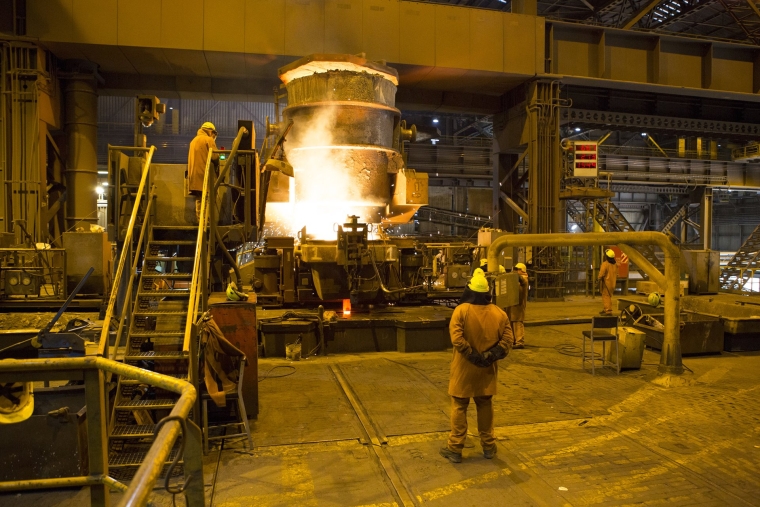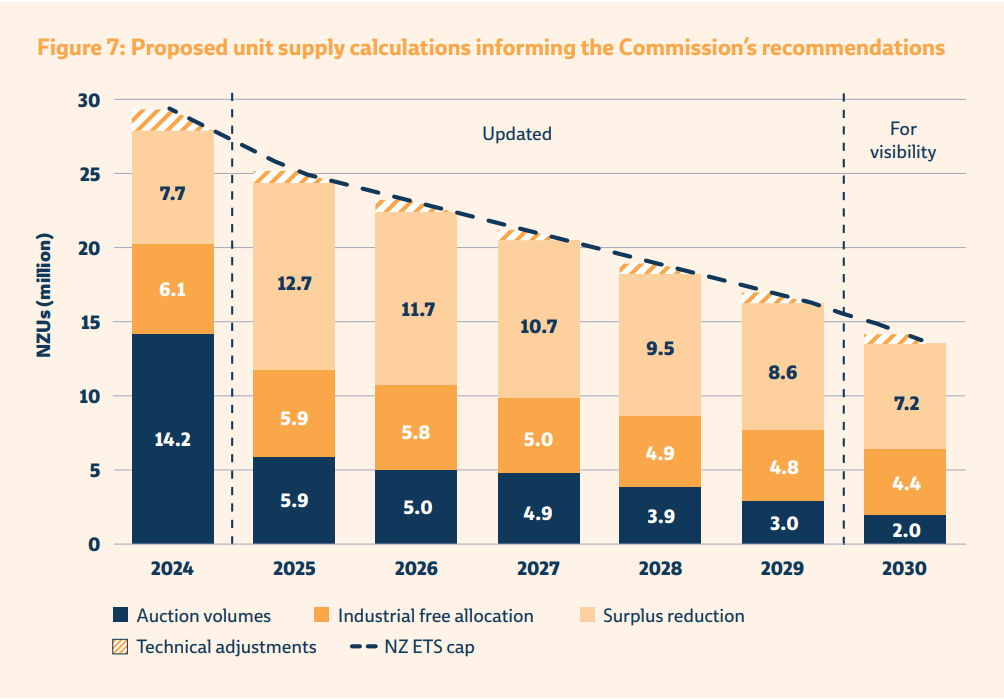
The number of Emission Trading Scheme (ETS) units given to exposed industries for free will soon be greater than those sold to other businesses through government auctions.
Advice provided by the Climate Change Commission last week recommended halving the number of units sold in auctions from 2025 onwards to correct for a historic oversupply.
However, the Commission does not have authority to provide advice on the number of free units given to certain industries. These have a phase out schedule written into law.
This means the number of units up for auction will drop below the number given away free after 2025, if the Government adopts the Commission’s advice.
Climate Change Commissioner Catherine Leining said the industrial allocation settings are written into legislation and therefore the Commission did not give advice on volumes.
“It is certainly very striking … to see that we're now entering a period where the volume of the free allocation is greater than the auction volume,” she said.
There was potential for the Commission to advise on “either speeding up or slowing down” the legislated phase out rate, but it would need the Government to ask for that advice first.

No plan but no fan
Associate Climate Minister Nicola Willis said the Government was not currently proposing any changes to those settings but also that she was not a fan of emission subsidies.
“I’m really wary of any policy that, whether upfront or by a backdoor, is subsidizing people to pollute”.
The industrial allocation protects businesses in emissions-intensive activities that may be competing with rivals overseas who are not subject to a carbon tax.
If emissions pricing pushed production into countries with looser rules and dirtier energy, New Zealand would lose economic activity and global emissions would increase anyway.
New Zealand Steel Development was by far the largest recipient of free units in 2022. It received 1.9 million units, which would have cost $147 million if bought at auctions.
Methanol producer Methanex was the next biggest recipient with 838,400 free units worth $65 million. Fletcher Concrete and NZ Aluminium Smelters each got roughly $50 million worth.
The subsidy also goes to other smaller businesses such as a handful of rose growers and capsicum producers. Tomato growers got almost $3 million for their heated greenhouses.
In total, almost half a billion dollars worth of free units were given away during 2022.
Faster phase out?
Leining said previous advice had suggested maintaining the current phase out rate would not necessarily be consistent with the 2050 target.
However, since then the Government has passed some amendments that should lower future allocations. Those updated calculations have not yet been released or baked into forecasts.
Current forecasts show the industrial free allocation is likely to make up approximately 25% of the total emissions volume allocated to ETS sectors between 2025 and 2029.
However, much of that 75% has already been issued in previous auctions and from more forestry being recognised in the system.
This means the Climate Change Commission has recommended selling just 5.9 million units at auction during 2025 — equal to the number of units expected to be given away for free.
By 2030, the industrial free allocation will be more than double the number of units up for auction based on the current forecasts and settings recommendations.
A 2021 paper by economic research firm Motu suggested using a “more refined and more frequent assessment of emissions leakage” to ensure the free allocation was only being handed out where necessary.
However, some level of free allocation would be needed to prevent emissions leakage in the absence of some global cooperation on carbon pricing.
20 Comments
You gotta laugh. Not one government has ever been able to make the ETS work as it was intended.
Which leads me to believe it was never the right approach at all;
For the simplest form of climate policy, we would count only carbon dioxide emissions; put a tax on carbon emitters (with no concessions for the Emissions Intensive, Trade Exposed (EITE) industries) and scrap the ETS. Additionally, we would cost-recover public transport based on its emissions profile only.
Provided we kept increasing capacity on PT to meet increased demand, with the above framework AND a ban on synthetic nitrogen, we’d likely meet our Paris commitments without the need for any other policy initiatives.
https://www.interest.co.nz/opinion/102433/katharine-moody-government-op…
"AND a ban on synthetic nitrogen"
NZ death warrant
Usual response of many. Tax it and with any govt. spend it on something which is not related to reducing emissions.
For a long time, New Zealand had no need for nitrogen fertilisers.
All of the nitrogen farms needed came from white clover, a legume grown across large parts of the country. It is one of the few plants able to fix nitrogen from the air.
Plants need both nitrogen and phosphorus to grow. Farmers complemented this natural nitrogen source with Superphosphate, a fertiliser made from phosphate rock extracted from Nauru and Banaba in the Pacific Islands.
It was with the construction of the Kapuni urea plant that synthetic nitrogen took off in New Zealand. With a regular local supply, farmers started buying urea en masse… The amount of nitrogen fixed by clover has fallen as urea usage has increased.
https://www.stuff.co.nz/business/farming/105864564/what-grows-the-grass…
Not being knowledgeable on this but I'd suggest the old fashioned way of white clover would require fields lying fallow or at least unused while the white clover did its N fixing. Fields lying fallow or crop rotation is something they did a long time ago and the desired crop density would reduce drastically, So maybe not a death sentence but mortally wounded with a slow death sentence.
Yes, we would have to return to a less intensive model of farming animals, but (from what I've read) not necessarily a less profitable one;
https://pureadvantage.org/campaigns/ourregenerativefuturecampaign/
https://www.newshub.co.nz/home/rural/2020/09/is-regenerative-agricultur…
As always Kate I'm suspicious of groups that claim 'run your business using this thing/method that looks less profitable, I promise it's not, it's actually more profitable'.
As a business owner I'd give it a sniff. If there are profitability advantages I'd implement it. And if that is the case then there's no need for a policy setting adjustment because the private sector would implement the new thing/method of it's own accord.
If however all of the net benefits accrue to the commons and not the private business then there's an issue. That's actually one of the few cases in which a subsidy is warranted.
no the white clover is a good feed crop . Tree lucerne is another nitrogen fixer , that can also be used as fodder.
clover has been taken over by rye grass hybrids , which you can almost see growing if fed large amounts of fertiliser. a side effect is the horrible facial eczema.
White clover still is a very important part of farming. Intensity of farming does have a big effect on its ability to thrive. Despite people trying to infer other wise our use of nitrogen fertilizer is way less overall than most other developed Agri world wide.
If the Crown gives away 6.1 million carbon units (NZUs), Govt's operating balance reduces by about $400m and Govt net worth reduces by the same amount. What?
Yep, NZUs are like mini-bonds with a value that floats at the market value of NZUs. So, when Govt gives NZUs away, they increases Crown liabilities (debt). When owners of 'given away' NZUs surrender those NZUs (i.e. when they pollute), the Govt's operating balance goes back up again and the liability is wiped out. So, basically as you were.
Obviously when Govt finally stop giving NZUs away, and polluters are handing in more NZUs than they receive, the Govt's operating balance will go up meaning they can spend more on other things.
It is a bit different when Govt auctions NZUs. The cash received when NZUs are sold is basically marked off the Govt's debt (and is not available for spending). The Govt's operating balance and net worth does not change. However, when auctioned NZUs are surrendered by their owners (when they pollute) the Govt's operating balance and net worth goes up and more money can be spent on other things.
The Govt has about $6bn worth of NZU liabilities. So, if Govt decided to give less units away (or auction less) then they would have a lot more money to spend.
And therein lies the beauty for the Government
The industrial allocation protects businesses in emissions-intensive activities that may be competing with rivals overseas who are not subject to a carbon tax.
If emissions pricing pushed production into countries with looser rules and dirtier energy, New Zealand would lose economic activity and global emissions would increase anyway.
Well government are looking for additionl tax revenue, just slap a carbon tax imported goods.
That's what the EU are going to do. Worth looking at. As is carbon tax on international travel/ shipping.
I'm shocked! Wash your mouth out. A tax on imported goods? That would go down well at the WTO cult. NZ would be cutting its throat setting the pace on this idea.
It won't be, the eu already doing it.
EU is looking at this. I think we'd run into issues with our FTAs though legally as it's a non-tariff barrier. But ultimately it's an adjustment that needs to occur. Our major trading partners (China, Australia, USA) either have no/very little in the way of carbon taxes so we are losing quite a bit of competitiveness on that front.
Let's get back to basics.
One - We are burning our way through a one-off stock of historical sunlight (fossil fuels).
Two - We are about half-way through that stock.
Three - even now, the exhaust of that burn is altering our habitat-envelope - inevitably in the direction of 'worse' (as you'd expect for a species optimised for conditions with the carbon locked away in the ground.
Four - burning the last half, will kill us off.
Five - but the leaders of this temporary nonsense, have a vested interest in short-term continuity. Aided by media silence, re 1 and 2.
This is why they decided on trading proxies - after all, it worked for Merrill Lynch, for a while.... So they set up a 'market' - what could go wrong?
The problem is that money is underwritten by energy (journalistic coverage of that issue within the following brackets ( ).
But trying to make money from the entropic exhaust of the burn, was double-dipping on an energy-source already reducing in EROEi. You cannot underwrite 'extra' money over and above that which is underwritten by energy - including future energy - without adding energy or creating an equivalent energy efficiency. (And the latter follow a pathway of diminishing returns, hence 'productivity' flattening off).
Outright rules would have worked, but are politically unacceptable to an uninformed voting populace. Emissions trading was always a failure-headed fudge.
Given human behaviour, and how individuals treat their own bodies properly in spite of fairly obvious and commonly known information, it's fairly optimistic to think they'd accept the implications and ramifications of even a 25% reduction in fossil fuel usage.
If humans can't adjust lifestyles in spite of decent evidence, then thats in essence evolution working as intended. Perhaps such intellect isn't compatible with primal drive.
You warning us on CC is like me warning us on Donald rapist Trump. No one is taking any notice of either of us. Trump is more likely to cause the planet to burn before CC will but there again I could be wrong. Let's hear you make the same admission.
"New Zealand was a net CO2 sink of −38.6 million ± 13.4 million tonne C yr−1."
A Comprehensive Assessment of Anthropogenic and Natural Sources and Sinks of Australasia's Carbon Budget
https://agupubs.onlinelibrary.wiley.com/doi/10.1029/2023GB007845
The definition of cluster f&@k in the dictionary has just been amended. * See NZ carbon scheme

We welcome your comments below. If you are not already registered, please register to comment
Remember we welcome robust, respectful and insightful debate. We don't welcome abusive or defamatory comments and will de-register those repeatedly making such comments. Our current comment policy is here.